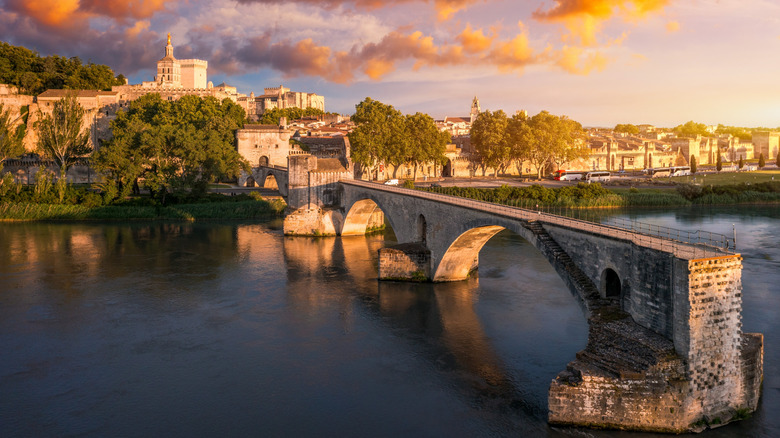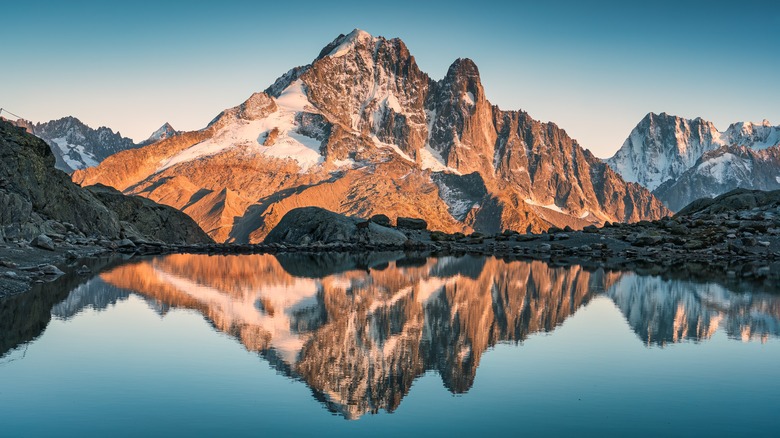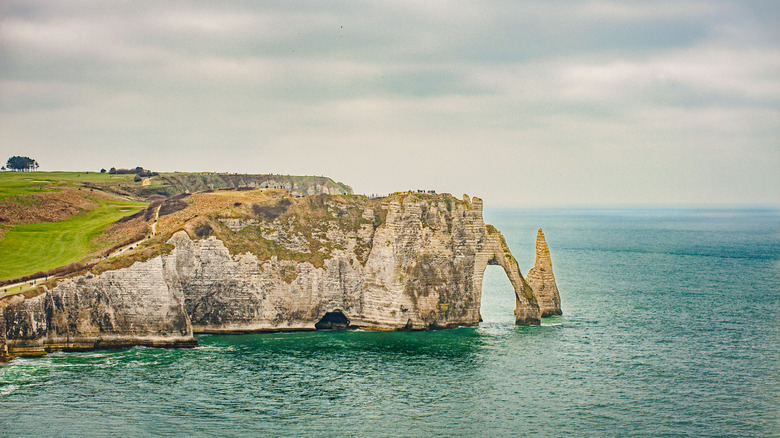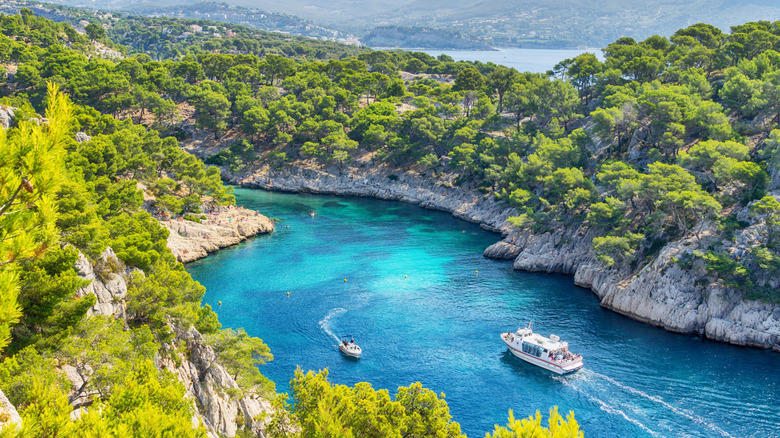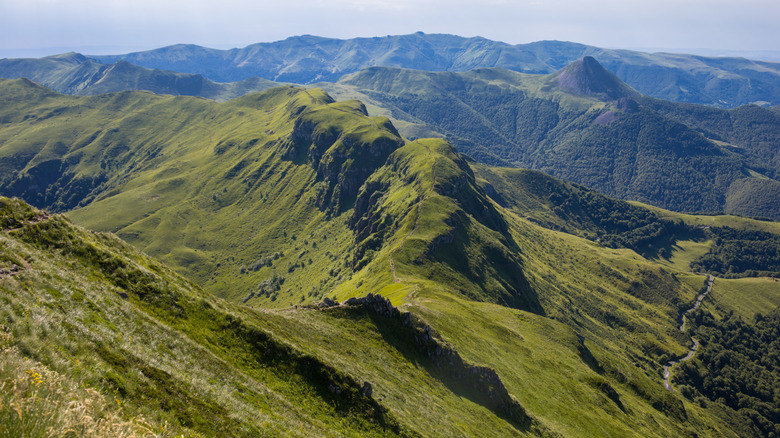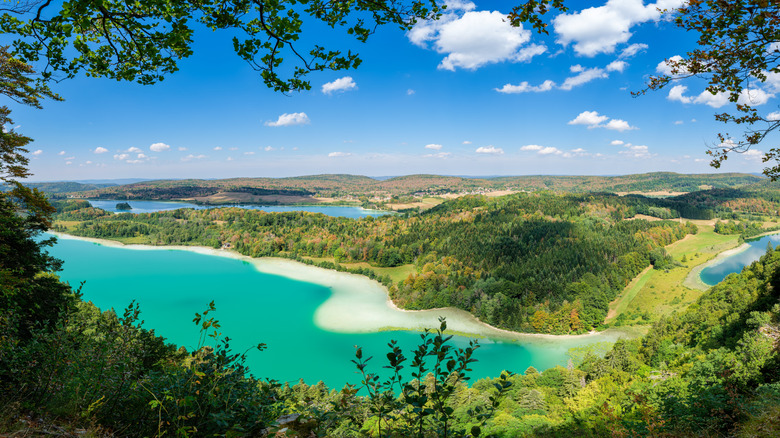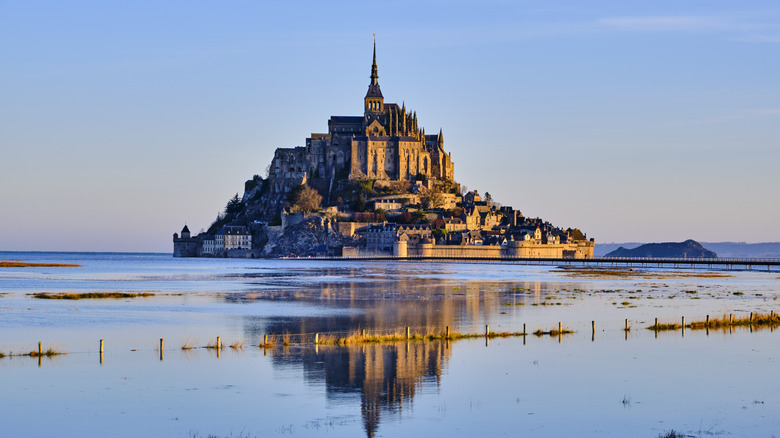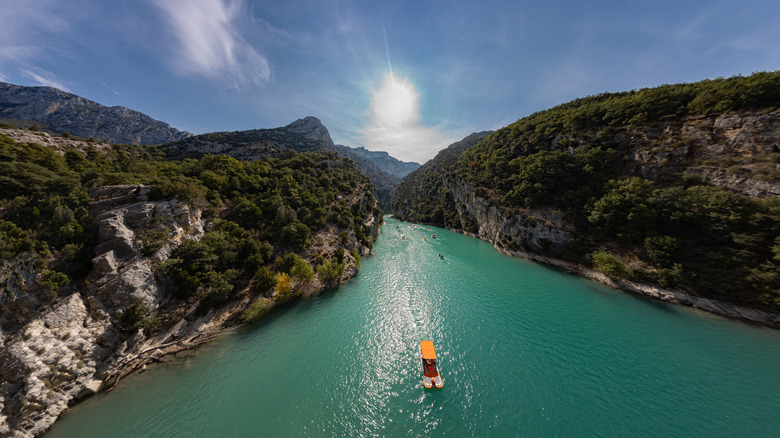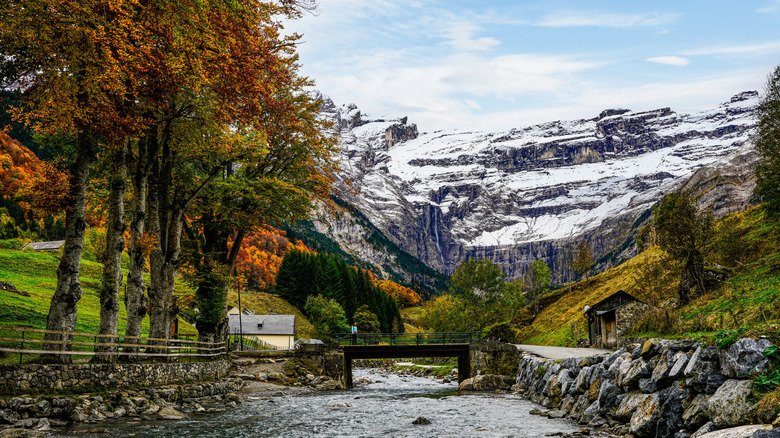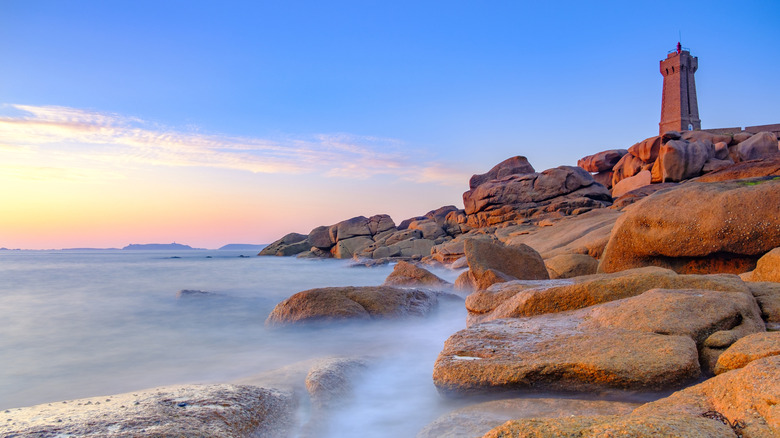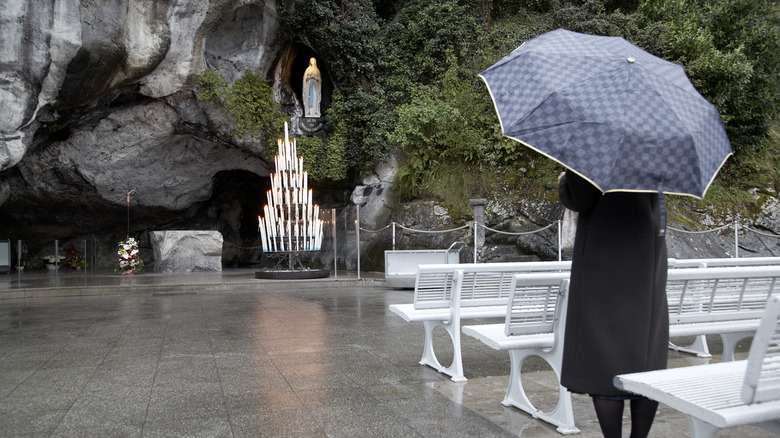The Most Overlooked Natural Wonders You Shouldn't Skip On A Trip To France
Landing in the French capital can feel like a regal affair, and entering Paris through its most affordable airport will please your wallet. Once you're out and about in the city, it's tempting to head straight to some of its highlights, like the Eiffel Tower, or seek strategic ways to explore the collections at the Louvre. No trip to Paris is complete without at least a cursory visit to these icons of the city. Similarly, you can't leave without devouring a divine Parisian baguette.
Once you've had your fill of the metropolitan landscape, consider exploring some of France's natural wonders. The country is surprisingly massive at 248,573 square miles. To put it into perspective, it is still larger than two Colorados combined (the state's square footage is 103,637.5). France also lies in an advantageous latitude zone — the bulk of the French mainland sits between 50˚N and 45˚N latitude. This places it roughly the same position as New York (and, more importantly) Washington or Oregon.
On the West Coast of the European mainland, France sees plenty of sun alongside ample rainfall. Throw in the tangled network of rivers, lakes, and mountains, and it's easy to see why the nation enjoys an abundance of truly spectacular scenery. These sites are some of the most breathtaking you'll find just about anywhere in Europe. It's enough to start planning a repeat visit before you've even completed your current adventure!
Catch the aroma of rolling lavender fields in the summer
Provence is a historically rich countryside region in the south of France. Nostradamus and Vincent van Gogh spent time here, as did a smattering of popes throughout history. The region is home to the Côte d'Azur alongside an endless rolling hillside dotted with lavender fields. Lavender is native to this region, although it's worth noting that the carefully cultivated fields supplying plenty of the global market are sowed in intentional, still iconic, rows. Provence is almost certainly the most prominent image that most people will have when thinking about the fragrant, deep purple flowers.
However, Bulgaria has overtaken the classic French production hub as the world leader in lavender oil production. Even so, traveling to France between June and August allows you to explore endless fields of lavender. Biking along Les Routes de la Lavande will get you out of the car or bus and place you in the thick of this flowering plant's growth cycle. Stops along the way also include museums, lavender oil distilleries, and lavender farms that will enmesh your senses in the fragrant scent of these flowers at peak ripeness.
Climb (or view from afar) the pinnacle of the French Alps, Mont Blanc
For hikers and climbers with plenty of experience and bravery, it's possible to ascend to the pinnacle of the European continent. Mont Blanc stands tall at 15,781 feet and certainly isn't for the inexperienced or faint of heart. However, it's possible to take a cable car from Chamonix to the Aiguille du Midi for a close-up view of the towering summit.
This peak rises to 12,605 feet and offers a majestic spot to explore the natural landscape without committing to an intense, multi-day hike. Alternatives that offer challenging hiking are in abundance, though, including Tour du Mont Blanc. This hiking route spans over 100 miles and brings travelers through Italy, Switzerland, and France to a number of peaks and village hamlets. Rick Steves conquered the trails of Tour du Mont Blanc in 2021 and considers it a transformative experience.
Views of the iconic peak don't have to include any climbing, though. For anyone who wants to keep their feet firmly on the ground, the alpine is visible in spectacular fashion from towns like Chamonix, Combloux, Saint-Gervais, and Sallanches, among others. No matter your selection, a trip to see the snowcapped lid of the European continent is a must for anyone looking to explore one of France's most stunning natural wonders.
View the towering cliffs at Étretat
The cliffs that dominate Normandy's shores are famous for many reasons. They're one of the world's most stunning coastlines and feature historical-codenamed sites like Omaha and Utah beaches, where Americans landed on D-Day. Another big reason visitors head out of the city and to the Channel coastline is to see Étretat's iconic pebble beaches, arching seaboards, and deep blue waters. Known as The Alabaster Coast, it sports some of the most beautiful coastlines you'll see anywhere. It offers a sort of mirror image to the white cliffs of Dover a bit farther east and on the other side of the narrow English Channel.
Coastal views aren't the only beauty to take in here, though. The Étretat Gardens offers a lively landscape of deep greenery for sitting and contemplation. Artists like Monet and Morisot spent time here in their prime, taking in the land and sea as inspiration for their works. The area is also great for walkers hoping to explore the landscape. Walking along the cliffs and breathing in the fresh ocean air on a warm, sunny day is perhaps an unrivaled experience you won't find anywhere else in France — let alone beyond it.
Watch dolphins playing in the waters of the Calanques of Marseilles
The Calanques form a 12.5-mile stretch of coastline near Marseilles that supports a unique ecosystem of plant and animal life. The area was marked Parc National des Calanques in 2012 and has been deemed protected since. It's one of the few areas of the world to exhibit fjords (also found in Oman, Chile, New Zealand, and most notably, throughout Norway). Visitors can expect a refreshing aquatic seascape, a lively hiking adventure, or perhaps a bit of both. The habitat supports an immensity of fish species. Dolphins have been known to hunt in these waters and come up to put on a show for onlookers.
The turquoise waters are incredibly inviting, and a dip here is well worth the trip from the city (or another metropolitan area in France like Nice or even Chamonix after a gawk at Mont Blanc). The Mediterranean waters along France's Côte d'Azur are warmer than the ocean depths found along the country's other coasts, making this a better place to swim during an off-peak visit outside the summer or springtime seasons. In 600 BC, the Greeks arrived here, and the Fontaine de Voire played an integral role in forging a bond between the local inhabitants and their visitors, ultimately leading to the foundation of the city of Marseilles itself. This makes these waters a decent stop for those looking to explore French history, too!
Take a hot air balloon trip over Volcans d'Auvergne
The Parc des Volcans d'Avergne is the largest volcanic landscape in Europe, with a 400,000-hectare boundary covered in rolling hilltops. Countless eruptions from a chain of now-dormant volcanoes formed these hills. Over eons, oozing magma that careened out of their cracks and crevasses has resulted in the gradual curvature of the landscape, dotted with trees and other natural growth. The volcanic national park was designated in 1977 and is found in roughly the center of France, halfway between Lyon and Bordeaux. The hills rise to nearly 2,000 meters in some areas, with a smattering of much shorter rises also factoring into the tumbling landscape.
Almost certainly, the best way to take in the true magnitude of the region's teeming foliage and sea of rolling hills is by hot air balloon. Rising high above the magma-created features gives you a unique sense of scale and allows for an enriching, 360-degree view of the park's magnificence. Another option is to bike through the trails scattered around these hills. Much like heading out for a hike, remaining on the ground and exploring by bicycle places you in the thick of the greenscape's overflow of natural beauty.
Hike or drive around the glacial lakes of Jura
Jura is a department in the Bourgogne-Franche-Comté region and is a majestic sight to behold. It borders Switzerland to the east and is found near the southeast corner. It's a mountainous swath of France that features some of the most spectacular glacial lakes you'll see anywhere in the world. Jura is one of those unique off-the-radar French experiences.
In total, 70 glacial water bodies lie throughout the Haut-Jura landscape. Travelers looking to get lost in nature should explore the Route des Lacs du Jura. This is a 93-mile road route that brings visitors around a series of Jura's most fascinatingly gorgeous lakes. Most notable are Chambly, Antre, Etival, Chalain, Bonlieu, and many others (about 20 lakes are on this path). You'll also head over the Pyle Bridge as it crosses Lake Vouglans.
Along the route, you'll encounter the Vallée du Hérisson and the Plateau des 7 Lacs, which has a winding collection of lakes and waterfalls. The 31 falls in this part of the route are the largest collection of waterfalls in France and are sure to yield fantastic pictures. Within the Lac du Vouglans, you can visit the Island of Maurice, named after a man who secluded himself on the distant landmass in the 1990s. Naturally, this is also a fabulous place to get your hiking boots on. Just about any of the dozens of lakes can make for an enchanting hike in the fresh mountain air.
Explore the Mont Saint-Michel Abbey, situated on an island in a UNESCO-listed bay
Another UNESCO site in France, the Mont Saint-Michel Bay, is found between Normandy and Brittany in the northwestern coastal expanse. The region experiences France's most prominent tidal movements, and the salt marshes here are the largest in the country. Visitors can explore the beaches and look for wild mussels at low tide or head straight to one of the most striking destinations in the area.
Roughly 2.5 million visitors head to the abbey on an island in the bay every year. It's a veritable floating French castle thrust onto some of the most stunningly beautiful water you'll ever lay eyes on. The structure saw its construction begin in 966 with the help of Normandy's dukes and the French king, chasing after a local bishop's dream of giving the Archangel Michael a church at the very top of the island.
Today, the abbey and its surrounding buildings form a magnetic tourist draw — making the historic structure one of the most visited castles in France. But nature lovers will also want to catch a glimpse of the widespread bay's marine environment. One hundred and thirty unique bird species call this area home. There's also a hugely diverse ecosystem of fish, dolphins, and seals that flutter beneath the waves.
Hike the Gorges du Verdon
The Gorges du Verdon are sometimes known as "Europe's Grand Canyon," and the limestone cliffs that sit in the shadows of the magnificent Alps certainly live up to that moniker. The gorge landscape is found in Haute-Provence, so it makes for a nice day trip when exploring regional highlights like Nice (or the region's lavender fields!). Parc Naturel Régional du Verdon features cliffs that rise as high as 2,297 feet. The outdoor haven is perfect for a picnic. More adventurous travelers will find it a treat, with plenty of climbing and hiking opportunities in the rocky, craggy rises.
Furthermore, a series of waterways make their presence known with serious force. Visitors can go for a dip in the warm waters of southern France or strap into a kayak to explore the aquatic environment from a slightly dryer vantage point. Finally, visitors looking for something different might consider a paragliding trip or even bungee jumping over the gorges. These activities are sure to get your heart pumping and leave you with a lasting memory.
Take in the awesome atmosphere of the 'Colosseum de la nature': The Cirque de Gavarnie
Tucked along the Pyrenees that form a border between France and Spain, visitors seeking a magnificent view in a secluded and stunning atmosphere won't find anything more breathtaking. The Cirque de Gavarnie is a UNESCO World Heritage Site nestled within the Pyrenees National Park. Visits aren't limited to warm weather months, so you can set your sights on the snowcapped mountains, whether the land under your feet is drenched in snow or bathed in warm green tones and dotted with flowery colors.
During the summer, you can hike the Cirque's mountainous trails and arrive at a magnificent waterfall near the bowl's ceiling. The Grande Cascade, Europe's second tallest waterfall, is visible from the floor of the cauldron, too. Victor Hugo once described this magnificent scoop of valley floor within the walls of the Pyrenees as a "colosseum de la nature." The tremendous scenes found here all year speak to that high praise and are sure to excite your sense of adventure.
Stare in awe at one of the world's only pink granite coasts in Brittany
A 6.2-mile stretch of coastline that abuts the English Channel in Brittany, the pink granite coast gets its name from the granite stone bathed in pinkish hues that lie scattered across the beach head. These stones are tossed in huge heaps as if placed at the whims of a giant or some other celestial force. The rounded faces of these granite slabs are the product of natural erosion from the wind and surf. Additionally, the rocks have been preserved in their existing state (free of human interference) since 1901.
One particular boulder is of unique interest to visitors exploring these massive geological entities. La Boule in Trégastel (right near the far western extent of the French landmass) is an impossibly round sphere that stands out among its misshapen peers. This French oddity is made even more spectacular due to its rarity. There are only three pink granite coastlines in the world, with one in Corsica — a French island in the Mediterranean. The final pink granite shore is on the "green island" of Qingdao, an island in the Yellow Sea off the coast of China.
For religiously inclined visitors: Touch the healing waters at Lourdes
Our last entry will be particularly special for some. Those seeking a religious experience will be pleased to learn that France has its fair share of iconography and religious heritage. From the 1st century, Catholicism has ebbed and flowed in French society. Religious worship has remained an important part of the tapestry of people and places that make up France. A number of popes have come from the nation, and Joan of Arc, the patron saint of France, looms large in the country's history.
As a result, one particularly stunning natural site that doubles as a religious place of pilgrimage may be the perfect addition to complete your French itinerary. Lourdes is a town in the Pyrenees along the border with Spain and has a unique historical and religious significance. In February 1858, an apparition came to a young girl named Bernadette Soubirous. Over the following days, the apparition returned several times, instructing Soubirous: "Go and drink from the spring and wash yourself there."
The apparition was none other than the Virgin Mary, and the sightings have been labeled a miracle by the Catholic Church. Since her first appearance, over 7,000 instances of healing from contact with the waters have been recorded. Over 5 million visitors pilgrimage to the town every year in hopes of experiencing the miraculous healing power.
